|
|
Updated as per James P. Tuttle's The Hawk Moths of North America, May 2011
Updated as per personal communication with Bill Dempwolf; May 2011
|
Western Texas
Sphingidae

Lintneria (Sphinx) istar or separatus, Ft. Davis,
Texas,
October 1, 2005,
courtesy of Mary Brown via Katherine McMahon.
This page is inspired by and dedicated to
Mary Brown and Katherine McMahon who sent me the pictures of the
Lintneria istar or Lintneria separatus larva from
Ft. Davis (Jeff Davis County) at the top
and bottom of this page.
Katherine writes, October 1, 2005,
"1) Geographical location: Ft. Davis, Texas (West Texas)
"2) accurate description of larva: about 15 centimeters long, 2
centimeters width, fleshy skin, light cream color with black
geometric marks and white spots
"3) description of caterpillar's activity:
Found on tall dried grass, between two small trees, in a field with
cattle near by, about 100 feet from a stream.
Early morning on October 1st. Temperature about 90 degrees.
"One of my friends took a picture of it. I can try to get it for you
if that would help."
I did not feel confident about my identification from the description,
but suggested it might be Eumorpha achemon, based on size proposed,
colouration and no mention of horn(s).
I was stumped when the image arrived, so I forwarded it to Jim Tuttle
who indicates, "The larva is either a last instar
Lintneria (Sphinx) istar or L. separatus. I cannot be
sure from the angle of the photo. I will be resurrecting the genus
Lintneria to address about 17-18 former members of
the genus Sphinx once my book is finally in print."
Seventy-five Sphingidae species are listed for Texas on the U.S.G.S.
website. Not all of the species are reported or anticipated in
the central region.
It is hoped
that this checklist, with the thumbnails and notes, will help you
quickly identify the moths you are likely to encounter.
A "USGS"
indicates the moth is reported on the USGS website and/or in
Lepidoptera of North America, #1. Distribution of Silkmoths (Saturniidae) and Hawkmoths (Sphingidae)
of Eastern North America,
an excellent little booklet available through Paul Opler.
Please help me develop this list with improved, documented accuracy
by sending sightings (species, date, location), preferably with an
electronic image, via email to
Bill Oehlke.
The night-blooming moon flower will attract many
Sphingidae at dusk and into the night.
Sphinginae subfamily
Sphingini tribe:
 |
This species is a strong migrant and adults nectar from
deep-throated flowers including moonflower (Calonyction aculeatum),
morning glory (Convolvulus), honey suckle (Lonicera)
and petunia (Petunia species).
|
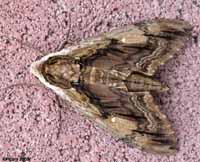 |
Ceratomia amyntor
USGS,
the Elm Sphinx or Four-horned Sphinx
The upperside of the forewing is brown with dark brown and white markings including a white costal area near the wing base, dark streaks along the veins,
and a white spot in the cell.
Larvae feed on Elm (Ulmus), birch (Betula), basswood (Tilia), and
cherry (Prunus). |
 |
The upperside of the forewing is pale brownish gray with wavy black and white lines and a black-outlined white cell spot.
The upperside of the hindwing is gray with diffuse darker bands. |
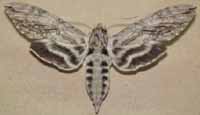 |
The upperside of the forewing is pale gray with a yellowish tint,
wavy black lines and dashes, and inconspicuous white spots.
|
 | The upperside of the forewing is dark gray with brown tinges. A
series of narrow dashes runs from the tip to the
cell spots, and a wide black band runs from the middle of the
outer margin to the base of the wing. It flies to the
east and to the south and might be present.
|
 | The upperside of the forewing is gray with wavy black and light
gray bands and two small gray spots near the center of the costa.
|
 | The upperside of the forewing is dark gray with black and light gray
wavy lines. The upperside of the hindwing is black with a brownish
gray border and two white bands.
|
 |
I suspect if you grow tomatoes, you are likely to encounter Manduca quinquemaculata.
|
 |
Look for three large yellow spots
on each side of the abdomen. The upperside of the forewing is
yellowish brown to deep chocolate brown with a dusting of white
scales and zigzagged black and white lines.
|
 |
If you grow tomatoes, you have probably encountered Manduca sexta
in the larval stage.
Larvae get very large and can strip a tomato plant.
|
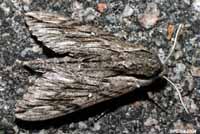 | The upperside of the forewing is gray with indistinct black and
white markings. There is a series of black dashes
from the base to the tip, and a small white cell spot.
|
 |
The upperside of the forewing is pale silver-gray with a series of
black dashes, a white patch at the tip, and a white stripe along the
outer margin. The upperside of the hindwing is black with blurry
white bands.
|
 |
Sphinx chersis
WO, the Northern Ash Sphinx or Great Ash
Sphinx
The upperside of the forewing is soft dark gray to
blue-gray with a series of black dashes, one of which reaches the
wing tip.
Larval hosts are ash, lilac, privet, cherry, and quaking aspen.
|
 | Sphinx dollii (Wing span: 1 3/4 - 2 1/2 inches (4.5 - 6.3 cm)),
flies in arid brushlands and desert foothills from Nevada and
southern California east through Utah,
Arizona, Colorado, and New Mexico to Oklahoma and Texas.
|
 | The upperside of the forewing is pale blue-gray to dark gray with a black dash reaching the wing tip and
a white stripe along the lower outer margin.
The upperside of the hindwing is black with two diffuse white
bands, the upper one being practically non-existent. Note complete black mesial
stripe on abdomen.
|
Sphinx libocedrus, Elephant Mountain Wildlife Management Area, April 24, 2011, Bill Dempwolf.
Smerinthini Tribe:
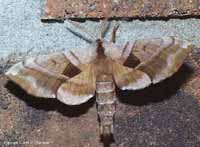 |
The adults are also highly variable; sometimes wings of an individual
may be all one color or may have several colors, ranging from pale to
dark brown, and may have a white or pink tinge. Patterns range from
faint to pronounced.
See the file for the female; she is different. |
Amorpha juglandis, Elephant Mountain Wildlife Management Area, April 24, 2011, Bill Dempwolf.
 |
Pachysphinx modesta
USGS,
the Modest Sphinx or Poplar Sphinx
They are common on Prince Edward Island, and are a very large bodied sphinx.
|
 |
The lines and bands of P. occidentalis, generally a more western species, are clearly formed, more so than the more diffuse lines and bands of
P. modesta generally a more easterly species. There are overlaps of the two ranges in western Texas.
|
Pachysphinx occidentalis, Elephant Mountain Wildlife Management Area, April 23, 2011, Bill Dempwolf.
Macroglossinae subfamily
Dilophonotini tribe:
 |
This species is sporadically reported southern Texas counties.
Males and females differ.
|
 |
During the night adults nectar at flowers, including bouncing bet
(Saponaria officinalis) and Asystasia gangetica beginning at dusk.
July and August are flight times in the southern states.
rare
|
Philampelini tribe:
 |
Larvae get large and feed on grape vines and Virginia creeper.
Note the differences between this moth and the Pandorus Sphinx. |
 |
The upperside of the moth is dark pinkish brown. Each forewing has a
lighter brown band along the costa, and sharp pinkish white bands and
streaks. The hindwing has a pink patch on the inner margin.
|
Macroglossini tribe:
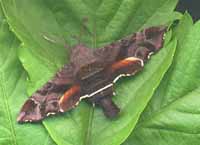 |
This day flier is widely distributed. If you have Virginia Creeper, you
probably have the Nessus Sphinx. Two bright, distinct, narrow yellow
bands are often visible on the abdomen.
|
 |
Darapsa myron USGS, the Virginia Creeper Sphinx or the Grapevine Sphinx
If you have the
foodplants indicated in the common names, you probably have this
species nearby. The lower wings are orange. |
 |
Hyles lineata
USGS, the White-lined Sphinx
This species has
strong migrating tendancies from much further south.
There are records from New Hampshire and Maine. |
 |
The upperside of the forewing is pale gray-green with a deep
green-brown median area and a white dash at the wing tip.
rare
|

|
The upperside of the forewing is orange-brown along the forward half, striped with dark brown and light brown along
the rear half, with dark brown bands separating the two.
The
upperside of the hindwing is pale brown with dark brown
marginal and submarginal lines.
Terry Doyle sent me an image of a larva from Big
Bend National Park, Brewster County.
|
 |
The upperside of the forewing is pale brown with lavender-gray at the
base and has dark brown lengthwise lines throughout. The upperside of
the hindwing is dark brown with a band of whitish, wedge-shaped marks.
|
|
|
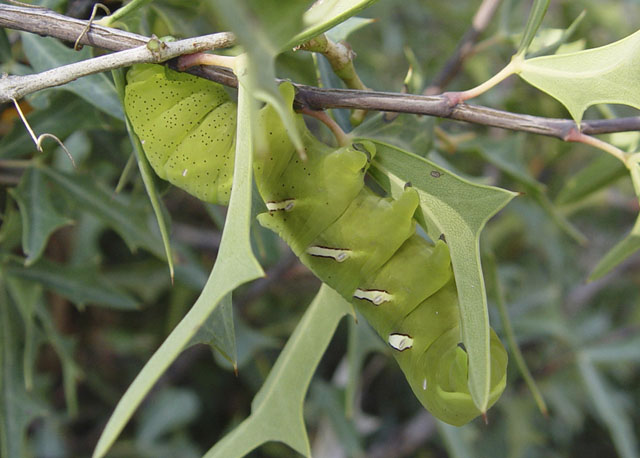
Eumorpha vitis, Austin, Texas, September 19, 2005, courtesy of
Melody Lytle.

Amorpha juglandis, female, Austin, Texas, courtesy
of Frances Schenkkan via Melody Lytle.
Enjoy some of nature's wonderments, giant silk moth cocoons.
These cocoons are for sale winter and fall. Beautiful Saturniidae moths will emerge the following spring and summer.
Read Actias luna rearing article.
Additional online help available.
Eggs of many North American species are offered during the spring and summer. Occasionally
summer Actias luna and summer Antheraea polyphemus cocoons are available. Shipping to US destinations is done
from with in the US.
Use your browser "Back" button to return to the previous page.
This page is brought to you by
Bill Oehlke and the
WLSS. Pages are on space rented from Bizland. If you would like
to become a "Patron of the Sphingidae Site", contact Bill.
Please send sightings/images to Bill. I will do my best to respond to
requests for identification help.
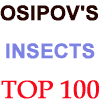 | 
Show appreciation for this site by clicking on flashing butterfly to the left.
The link will take you to a page with links to many insect sites. |
This website has been created and is maintained by Bill Oehlke without government or institutional financial assistance. All expenses, ie., text reference
support material, webspace rental from Bizland, computer repairs/replacements, backups systems, software for image adjustments (Adobe Photoshop; L-View),
ftp software, anti-virus protection, scanner, etc. are my own.
I very much appreciate all the many images that have been sent to me, or of which I have been granted permission to copy and post from other websites.
All images on this site remain the property of respective photographers.
If you would like to contribute to the maintenace of this website by sending a contribution to
Bill Oehlke
Box 476
155 Peardon Road
Montague, Prince Edward Island, C0A1R0
Canada
your donation would be much appreciated and would be used for
1) paying for webspace rental;
2) paying for computer maintenance and software upgrades;
3) purchases of additional text reference material (journals and books) in anticipation of expanding the site to a worldwide Sphingidae site;
4) helping to pay my daughter's tuition; with anything left over going to humanitarian aid.
If you are mailing a check from USA, please use $0.85 postage. Donations can also be made through Paypal via the button below.




